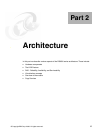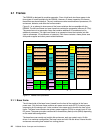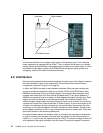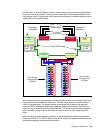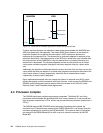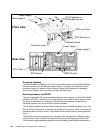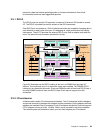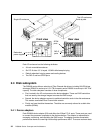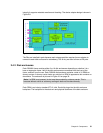24 DS8000 Series: Concepts and Architecture
If you can view Figure 2-3 on page 23 in color, you can use the colors as indicators of how the
DS8000 hardware is shared between the servers (the cross hatched color is green and the
lighter color is yellow). On the left side, the green server is running on the left-hand processor
complex. The green server uses the N-way SMP of the complex to perform its operations. It
records its write data and caches its read data in the volatile memory of the left-hand
complex. For fast-write data it has a persistent memory area on the right-hand processor
complex. To access the disk arrays under its management (the disks also being pictured in
green), it has its own device adapter (again in green). The yellow server on the right operates
in an identical fashion. The host adapters (in dark red) are deliberately not colored green or
yellow because they are shared between both servers.
2.2.1 Server-based SMP design
The DS8000 benefits from a fully assembled, leading edge processor and memory system.
Using SMPs as the primary processing engine sets the DS8000 apart from other disk storage
systems on the market. Additionally, the POWER5 processors used in the DS8000 support
the execution of two independent threads concurrently. This capability is referred to as
simultaneous multi-threading (SMT). The two threads running on the single processor share
a common L1 cache. The SMP/SMT design minimizes the likelihood of idle or overworked
processors, while a distributed processor design is more susceptible to an unbalanced
relationship of tasks to processors.
The design decision to use SMP memory as I/O cache is a key element of IBM’s storage
architecture. Although a separate I/O cache could provide fast access, it cannot match the
access speed of the SMP main memory. The decision to use the SMP main memory as the
cache proved itself in three generations of IBM’s Enterprise Storage Server (ESS 2105). The
performance roughly doubled with each generation. This performance improvement can be
traced to the capabilities of the completely integrated SMP, the processor speeds, the L1/L2
cache sizes and speeds, the memory bandwidth and response time, and the PCI bus
performance.
With the DS8000, the cache access has been accelerated further by making the Non-Volatile
Storage a part of the SMP memory.
All memory installed on any processor complex is accessible to all processors in that
complex. The addresses assigned to the memory are common across all processors in the
same complex. On the other hand, using the main memory of the SMP as the cache, leads to
a partitioned cache. Each processor has access to the processor complex’s main memory but
not to that of the other complex. You should keep this in mind with respect to load balancing
between processor complexes.
2.2.2 Cache management
Most if not all high-end disk systems have internal cache integrated into the system design,
and some amount of system cache is required for operation. Over time, cache sizes have
dramatically increased, but the ratio of cache size to system disk capacity has remained
nearly the same.
The DS6000 and DS8000 use the patent-pending
Sequential Prefetching in Adaptive
Replacement Cache (SARC)
algorithm, developed by IBM Storage Development in
partnership with IBM Research. It is a self-tuning, self-optimizing solution for a wide range of
workloads with a varying mix of sequential and random I/O streams. SARC is inspired by the
Adaptive Replacement Cache (ARC) algorithm and inherits many features from it. For a
detailed description of ARC see N. Megiddo and D. S. Modha, “Outperforming LRU with an
adaptive replacement cache algorithm,” IEEE Computer, vol. 37, no. 4, pp. 58–65, 2004.




